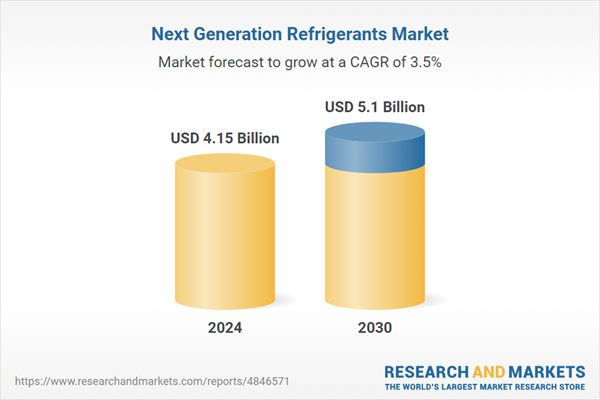Speak directly to the analyst to clarify any post sales queries you may have.
10% Free customizationThis report comes with 10% free customization, enabling you to add data that meets your specific business needs.
Market expansion is being driven by breakthroughs in refrigerant chemistry, the development of equipment optimized for new formulations, and the integration of IoT-based monitoring and performance management. Although the transition is challenged by factors such as elevated conversion costs, specialized handling requirements, and uneven supply chain readiness, the sector remains on a strong growth trajectory. Positioned at the forefront of the cooling industry’s decarbonization efforts, next-generation refrigerants present significant long-term opportunities for manufacturers, technology developers, and service providers that can adapt to the sector’s rapidly evolving environmental and operational benchmarks.
Key Market Drivers
Rising Demand for Energy-Efficient Cooling Solutions
Rising demand for energy-efficient cooling solutions is a significant growth catalyst for the global next-generation refrigerants market, driven by the combined pressures of increasing energy costs, environmental sustainability targets, and expanding cooling needs across diverse sectors. The global population reached 8 billion in November 2022 and, while growth is expected to slow in the coming decades, it is projected to peak at approximately 10.4 billion by the mid-2080s, rapid urbanization, and rising living standards especially in emerging economies are contributing to a surge in demand for air conditioning, refrigeration, and heat pump systems. At the same time, climate change is leading to higher average temperatures and longer warm seasons, intensifying the reliance on cooling solutions. This sustained demand is prompting end users to prioritize systems that deliver high performance while consuming less energy.Next-generation refrigerants, such as hydrofluoroolefins (HFOs) and natural refrigerants like CO₂, ammonia, and hydrocarbons, offer improved thermodynamic properties that enhance system efficiency. By enabling lower energy consumption without compromising cooling capacity, these refrigerants directly contribute to operational cost savings and reduced carbon emissions key considerations for both residential consumers and large-scale commercial operators.
Government regulations and international energy-efficiency standards are pushing manufacturers to redesign HVAC and refrigeration equipment for optimal performance with low-global-warming-potential (GWP) refrigerants. Businesses, particularly in the commercial and industrial sectors, are adopting these solutions not only for regulatory compliance but also to meet corporate sustainability goals and strengthen ESG performance. The market is seeing accelerated adoption of next-generation refrigerants in both new installations and retrofits, reinforcing their role as a central enabler of the global shift toward energy-efficient, climate-resilient cooling technologies.
Key Market Challenges
High Initial Transition and Equipment Upgrade Costs
Shifting from conventional high-global-warming-potential (GWP) refrigerants to next-generation alternatives often requires significant capital investment. Many existing HVAC and refrigeration systems are incompatible with low-GWP refrigerants such as hydrofluoroolefins (HFOs) or certain natural refrigerants, necessitating equipment replacement or costly retrofits. For large commercial and industrial facilities such as supermarkets, manufacturing plants, and data centers this conversion can involve complex system redesigns, safety modifications, and operational downtime. In price-sensitive markets, these upfront costs can deter adoption, especially among small and medium-sized enterprises.Key Market Trends
Rapid Emergence of Hybrid and Blended Refrigerant Formulations
A significant market trend is the growing adoption of refrigerant blends that combine hydrofluoroolefins (HFOs) with other low-global-warming-potential (GWP) compounds to balance performance, safety, and cost. These hybrid formulations are designed to optimize thermodynamic efficiency while addressing application-specific needs such as flammability reduction or compatibility with existing equipment. This approach allows industries to transition away from high-GWP hydrofluorocarbons (HFCs) without incurring the full cost of complete system overhauls, making them particularly attractive for large-scale commercial retrofits and industrial upgrades.Key Market Players
- Honeywell International Inc
- Zhejiang Juhua Co Ltd
- Arkema
- DAIKIN INDUSTRIES Ltd
- The Chemours Company
- SRF Limited
- Tazzetti S.p.A
- ASPEN Refrigerants Inc
- Linde PLC
- Harp International Ltd.
Report Scope:
In this report, the Global Next Generation Refrigerants Market has been segmented into the following categories, in addition to the industry trends which have also been detailed below:Next Generation Refrigerants Market, By Type:
- Natural Refrigerants
- Hydrofluoro Olefins
- Others
Next Generation Refrigerants Market, By Application:
- Air Conditioning
- Refrigeration
- Heat Pump
- Others
Next Generation Refrigerants Market, By End Use:
- Residential
- Industrial
- Commercial & Transportation
Next Generation Refrigerants Market, By Region:
- North America
- United States
- Canada
- Mexico
- Europe
- France
- United Kingdom
- Italy
- Germany
- Spain
- Asia-Pacific
- China
- India
- Japan
- Australia
- South Korea
- South America
- Brazil
- Argentina
- Colombia
- Middle East & Africa
- South Africa
- Saudi Arabia
- UAE
Competitive Landscape
Company Profiles: Detailed analysis of the major companies present in the Global Next Generation Refrigerants Market.Available Customizations:
With the given market data, the publisher offers customizations according to a company's specific needs. The following customization options are available for the report.Company Information
- Detailed analysis and profiling of additional market players (up to five).
This product will be delivered within 1-3 business days.
Table of Contents
Companies Mentioned
- Honeywell International Inc
- Zhejiang Juhua Co Ltd
- Arkema
- DAIKIN INDUSTRIES Ltd
- The Chemours Company
- SRF Limited
- Tazzetti S.p.A
- ASPEN Refrigerants Inc
- Linde PLC
- Harp International Ltd.
Table Information
| Report Attribute | Details |
|---|---|
| No. of Pages | 180 |
| Published | September 2025 |
| Forecast Period | 2024 - 2030 |
| Estimated Market Value ( USD | $ 4.15 Billion |
| Forecasted Market Value ( USD | $ 5.1 Billion |
| Compound Annual Growth Rate | 3.4% |
| Regions Covered | Global |
| No. of Companies Mentioned | 10 |









